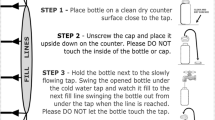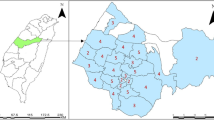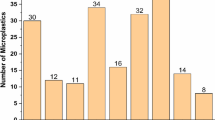Abstract
Assessing the health risk from lead (Pb) in potable water requires accurate quantification of the Pb concentration. Under worst-case scenarios of highly contaminated water samples, representative of public health concerns, up to 71–98 % of the total Pb was not quantified if water samples were not mixed thoroughly after standard preservation (i.e., addition of 0.15 % (v/v) HNO3). Thorough mixing after standard preservation improved recovery in all samples, but 35–81 % of the total Pb was still un-quantified in some samples. Transfer of samples from one bottle to another also created high errors (40–100 % of the total Pb was un-quantified in transferred samples). Although the United States Environmental Protection Agency’s standard protocol avoids most of these errors, certain methods considered EPA-equivalent allow these errors for regulatory compliance sampling. Moreover, routine monitoring for assessment of human Pb exposure in the USA has no standardized protocols for water sample handling and pre-treatment. Overall, while there is no reason to believe that sample handling and pre-treatment dramatically skew regulatory compliance with the US Pb action level, slight variations from one approved protocol to another may cause Pb-in-water health risks to be significantly underestimated, especially for unusual situations of “worst case” individual exposure to highly contaminated water.




Similar content being viewed by others
References
American Public Health Association (APHA), American Water Works Association, & Water Environment Federation. (1998). Standard methods for the examination of water and wastewater (20th ed.). Washington, DC: American Public Health Association.
Brown, M. J., Raymond, J., Homa, D., Kennedy, C., & Sinks, T. (2010). Association between children's blood lead levels, lead service lines, and water disinfection, Washington, DC, 1998–2006. Environ Research, 111(1), 67–74.
Cartier, C., Prévost, M., Nour, S., & Pirog, M. (2009). A rapid method for the detection of lead service lines. American Water Works Association Water Quality and Technology Conference (WQTC), Seattle, WA.
Cartier, C., Laroche, L., Deshommes, E., Nour, S., Richard, G., Edwards, M., & Prévost, M. (2011). Investigating dissolved lead at the tap using various sampling protocols. Journal of American Water Works Association, 103(3), 55–67.
Centers for Disease Control and Prevention (CDC). (2002). Managing elevated blood lead levels among young children. Recommendations from the Advisory Committee on Childhood Lead Poisoning Prevention.
Centers for Disease Control and Prevention (CDC). (2004). Blood lead levels in residents of homes with elevated lead in tap water—District of Columbia, 2004. Morbidity and Mortality Weekly Report, 53, 268–270.
Deshommes, E., Laroche, L., Nour, S., Cartier, C., & Prévost, M. (2010). Source and occurrence of particulate lead in tap water. Water Research, 44(12), 3734–3744.
Edwards, M., Triantafyllidou, S., & Best, D. (2009). Elevated blood lead in young children due to lead-contaminated drinking water: Washington, DC, 2001–2004. Environmental Science & Technology, 43(5), 1618–1623.
Galke, W., Dixon, S., McLaine, P., Wilson, J., & Ashley, P. (2006). US Department of Housing and Urban Development. Study of HUDs Risk Assessment Methodology in three U.S. Communities. Available from: http://www.nchh.org/LinkClick.aspx?fileticket=HZUenslvU/0=&tabid=217. Accessed 7/10/2010
Goebel, A., Vos, T., Louwagie, A., Lundbohm, L., & Brown, J. H. (2004). Lead-testing service to elementary and secondary schools using anodic stripping voltammetry. Journal of Chemical Education, 81, 214–217.
Guidotti, T. L., Calhoun, T., John, O., Davies-Cole, J. O., Knuckles, M. E., Stokes, L., Glymph, C., Lum, G., Moses, M. S., Goldsmith, D. F., & Ragain, L. (2007). Elevated lead in drinking water in Washington DC, 2003–2004: the public health response. Environmental Health Perspectives, 115, 695–701.
Hu, J., Gan, F., Nguyen, C., & Edwards, M. (2010). Galvanic corrosion of lead pipe after partial lead line replacements. Proceedings of the European Corrosion Congress Moscow, Russia, 13–17 September
Levin, R., Brown, M. J., Kashtock, M. E., Jacobs, D. E., Whelan, E. A., Rodman, J., Schock, M. R., Padilla, A., & Sinks, T. (2008). Lead exposures in U.S. children, 2008: implications for prevention. Environmental Health Perspectives, 116(10), 1285–1293.
Lytle, D., Schock, M., Dues, N., & Clark, P. (1993). Investigating the preferential dissolution of lead from solder particulates. Journal of American Water Works Association, 85(7), 104–110.
Nguyen, C. K., Stone, K. R., Dudi, A., & Edwards, M. A. (2010). Corrosive microenvironments at lead solder surfaces arising from galvanic corrosion with copper pipe. Environmental Science & Technology, 44(18), 7076–7081.
Palintest. (1999). Method 1001: lead in drinking water by differential pulse anodic stripping voltametry. Erlanger: Palintest Ltd.
Portland, OR Water Bureau. Manual on “How to plan for, collect and return your water sample for lead testing”. Available from: http://web.multco.us/sites/default/files/health/documents/water_test_kit_instructions.pdf. Accessed 10/10/2010
Schock, M. R. (1990). Causes of temporal variability of lead in domestic plumbing systems. Environmental Monitoring and Assessment, 15(1), 59–82.
Schock, M. R., & Lemieux, F. G. (2010). Challenges in addressing variability of lead in domestic plumbing. Water Science & Technology: Water Supply-WSTWS, 10(5), 793–799.
Triantafyllidou, S., & Edwards, M. (2011a). Lead (Pb) in tap water and in blood: implications for lead exposure in the United States. Critical Reviews in Environmental Science and Technology. doi:10.1080/10643389.2011.556556.
Triantafyllidou, S., & Edwards, M. (2011b). Galvanic corrosion after simulated small-scale partial lead service line replacements. Journal of American Water Works Association, 103(9), 85–99.
Triantafyllidou, S., Parks, J., & Edwards, M. (2007). Particulate lead in drinking water. Journal of American Water Works Association, 99(6), 107–117.
US EPA (1991). Drinking water regulations: maximum contaminant level goals and national drinking water regulations for lead and copper. Federal Register, 56(110), 26460–26564.
US EPA (1994a). Method 200.8. Determination of Trace Elements in Waters and Wastes By Inductively Coupled Plasma - Mass Spectrometry Revision 5.4. Environmental Monitoring Systems Laboratory, Office of Research and Development, U.S. Environmental Protection Agency, Cincinnati, Ohio 45268.
US EPA (1994b). Method 200.9. Determination of Trace Elements by Stabilized Temperature Graphite Furnace Atomic Absorption Revision 2.2, Environmental Monitoring Systems Laboratory, Office of Research and Development, U.S. Environmental Protection Agency, Cincinnati, Ohio 45268.
US EPA (2003). Method 200.5. Determination of Trace Elements by Axially Viewed Inductively Coupled Plasma Atomic Emission Spectrometry Revision 4.2, Environmental Monitoring Systems Laboratory, Office of Research and Development, U.S. Environmental Protection Agency, Cincinnati, Ohio 45268.
US EPA (2009). Analytical Methods Approved for Drinking Water Compliance Monitoring of Inorganic Contaminants and Other Inorganic Constituents. Available from: at http://www.epa.gov/ogwdw/methods/pdfs/methods/methods_inorganic.pdf. Accessed 10/10/2010
US EPA, Office of Water. (2006). Memorandum on Management of Aerators during collection of tap samples to comply with the Lead and Copper Rule.
Zhang, Y., Griffin, A., Rahman, M., Camper, A., Baribeau, H., & Edwards, M. (2009). Lead contamination of potable water due to nitrification. Environmental Science & Technology, 43(6), 1890–1895.
Acknowledgments
The authors acknowledge the financial support of the National Science Foundation under grant CBET-0933246. Opinions and findings expressed herein are those of the authors and do not necessarily reflect the views of the National Science Foundation. The authors are grateful to John A. Consolvo of the Philadelphia Water Department (USA) for answering questions relevant to Pb-in-water quantification methods and for providing comments to improve the quality of this manuscript. The authors would also like to thank the anonymous reviewers for their valuable comments.
Author information
Authors and Affiliations
Corresponding author
Rights and permissions
About this article
Cite this article
Triantafyllidou, S., Nguyen, C.K., Zhang, Y. et al. Lead (Pb) quantification in potable water samples: implications for regulatory compliance and assessment of human exposure. Environ Monit Assess 185, 1355–1365 (2013). https://doi.org/10.1007/s10661-012-2637-6
Received:
Accepted:
Published:
Issue Date:
DOI: https://doi.org/10.1007/s10661-012-2637-6




